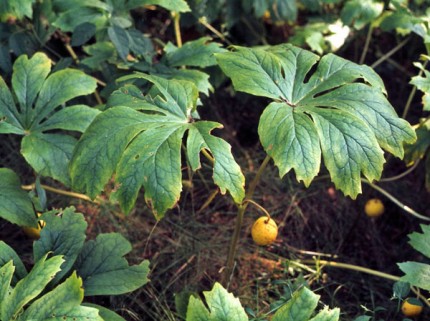
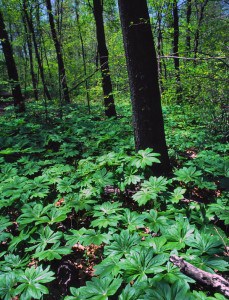
(Chelsea Update would like to thank Tom Hodgson and the Waterloo Natural History Association for the information in this story.)
Hidden among the ground plants in many woods and thickets in southern Michigan is an edible plant that is very seldom harvested. And, its name – May apple – is very misleading.
The May apple’s golf-ball sized fruits ripen in late July through September, not in May and are more the color of lemons than apples.
The roots of May apple are long lived, and send up new stems year after year. Over time they spread and form large colonies.
The stems and leaves first appear in spring when many other plants are still dormant. They sprout very quickly and reach their full height of 12-to-18 inches in about a week. They look like small umbrellas or miniature palm trees. Each underground root will send up several sprouts, and some will have one leaf with the stem attached at the center. Others will have two leaves attached to a forked stem.
In May, a single white blossom appears in the fork of the stem between the two leaves. From this flower, a single fruit develops and slowly ripens over the summer. Spring is the best time to locate May apple colonies. They stand out in stark contrast to the leaves on the forest floor. Yet, in late summer the conditions will be quite different because other plants will have grown up around the May apples.
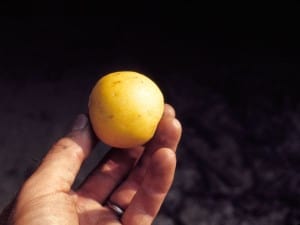
As the fruits ripen, the leaves and stems often turn yellow and fall to the ground. One will have to look closely to find them. If the eyes fail, follow the nose, as the ripe fruit have a sweet pungent odor that can be detected from some distance. When ripe the fruits are pale to bright lemon yellow and may be found still attached to the plant or lying on the ground.
Their flavor is tart, not unlike that of the inside of a concord grape.
Although edible and good when fully ripe, like prunes, they must be eaten in moderation. May apples are at their best in preserves.
The following recipe for May apple Marmalade is taken from the book, “Stalking the Wild Asparagus” by the late Euell Gibbons. To make May apple marmalade you will need the following:
- ½ gallon ripe May apples
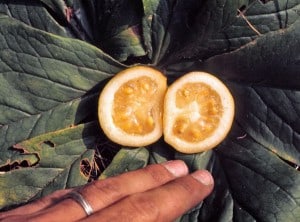
Courtesy photo. Inside a May apple fruit.
- 1 cup water
- 1 box Sure-jell
- 5 cups sugar
- jars and paraffin
Remove the stem and blossom ends from the washed fruit. Cut into quarters and put into a suitable sized kettle. Add the water and simmer 15 minutes, stirring occasionally to prevent sticking.
When the fruit is soft, put through a colander to remove the seeds and skins. Add a box of Sure-jell to four cups of the pulp and bring to a boil. Add the sugar.
Return to a boil for one minute. Skim and pour immediately into prepared jars and seal with paraffin. I’m sure you will be pleased with the results.
In dry summers, the plants die back early and little fruit is produced. This summer we have had adequate moisture, and the plants are in good condition and are producing fruit.
There are many May apple colonies along the trails at the Discovery Center and other moist woodlands in Waterloo. It is perfectly legal to pick edible fruits and berries from state land.
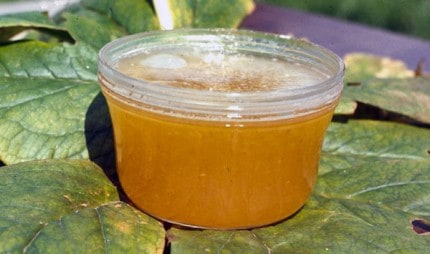



















After missing out on these fruits for years, I finally found the key. Pick them unripe (before the deer eat them) and let them ripen on a window sill. They are toxic when unripe, but like a magical tropical fruit when perfectly ripe. Well worth stealing from the deer – and really there are plenty to share. I really liked adding them to smoothies, and they make a very precious unusual juice as well. To me, the recipe given would be way too sweet. But that was true with most of Euell’s recipes. He was in favor of lots sugar or frying, which really tends to mask the fresh wonderful flavors of wild foods. He was an important pioneer of wildcrafting, but not much of a discerning cook.